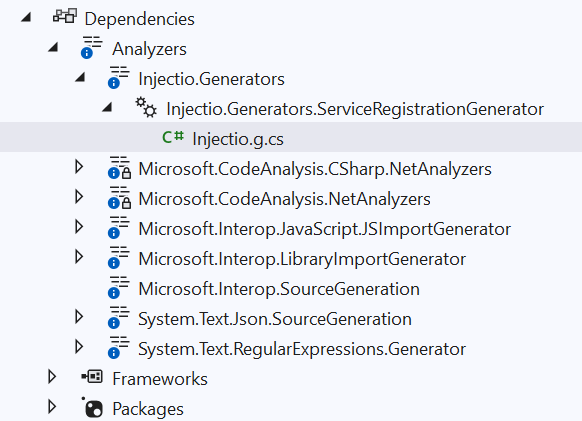Injectio by LoreSoft
NuGet / site data
Details
Info
Name: Injectio
Source generator that automatically registers discovered services in dependency injection
Author: LoreSoft
NuGet: https://www.nuget.org/packages/Injectio/
You can find more details at https://github.com/loresoft/Injectio
Original Readme
Injectio
Source generator that helps register attribute marked services in the dependency injection ServiceCollection
Features
- Transient, Singleton, Scoped service registration
- Factory registration
- Module method registration
- Duplicate Strategy - Skip,Replace,Append
- Registration Strategy - Self, Implemented Interfaces, Self With Interfaces
Usage
Add package
Add the nuget package project to your projects.
dotnet add package Injectio
Prevent dependances from including Injectio
<PackageReference Include="Injectio" PrivateAssets="all" />
Registration Attributes
Place registration attribute on class. The class will be discovered and registered.
[RegisterSingleton]Marks the class as a singleton service[RegisterScoped]Marks the class as a scoped service[RegisterTransient]Marks the class as a transient service[RegisterServices]Marks the method to be called to register services
Attribute Properties
| Property | Description |
|---|---|
| ImplementationType | The type that implements the service. If not set, the class the attribute is on will be used. |
| ServiceType | The type of the service. If not set, the Registration property used to determine what is registered. |
| Factory | Name of a factory method to create new instances of the service implementation. |
| Duplicate | How the generator handles duplicate registrations. See Duplicate Strategy |
| Registration | How the generator determines what to register. See Registration Strategy |
Duplicate Strategy
| Value | Description |
|---|---|
| Skip | Skips registrations for services that already exists |
| Replace | Replaces existing service registrations |
| Append | Appends a new registration for existing services |
Registration Strategy
| Value | Description |
|---|---|
| Self | Registers each matching concrete type as itself |
| ImplementedInterfaces | Registers each matching concrete type as all of its implemented interfaces |
| SelfWithInterfaces | Registers each matching concrete type as all of its implemented interfaces and itself |
Singleton services
[RegisterSingleton]
public class SingletonService : IService { }
Explicit service type
[RegisterSingleton(ServiceType = typeof(IService))]
public class SingletonService : IService { }
Support resolving multiple services with IEnumerable<T>
[RegisterSingleton(Duplicate = DuplicateStrategy.Append)]
public class SingletonService : IService { }
Scoped Services
[RegisterScoped]
public class ScopedService : IService { }
Transient Services
[RegisterTransient]
public class TransientService : IService { }
Factories
[RegisterTransient(Factory = nameof(ServiceFactory))]
public class FactoryService : IFactoryService
{
private readonly IService _service;
public FactoryService(IService service)
{
_service = service;
}
public static IFactoryService ServiceFactory(IServiceProvider serviceProvider)
{
return new FactoryService(serviceProvider.GetService<IService>());
}
}
Generic Attributes
You can use generic attributes to register services if your project targets net7.0.
<Project Sdk="Microsoft.NET.Sdk">
<PropertyGroup>
<TargetFrameworks>net7.0</TargetFrameworks>
</PropertyGroup>
</Project>
Generic attributes allow declaration to be more compact by avoiding the typeof calls
[RegisterSingleton<IService>]
public class ServiceImplementation : IService { }
Open Generic
[RegisterSingleton(ImplementationType = typeof(OpenGeneric<>), ServiceType = typeof(IOpenGeneric<>))]
public class OpenGeneric<T> : IOpenGeneric<T> { }
Register Method
When the service registration is complex, use the RegisterServices attribute on a method that has a parameter of IServiceCollection or ServiceCollection
public class RegistrationModule
{
[RegisterServices]
public static void Register(IServiceCollection services)
{
services.TryAddTransient<IModuleService, ModuleService>();
}
}
Add to container
The source generator creates an extension method with all the discovered services registered. Call the generated extension method to add the services to the container. The extension method will be called Add[AssemblyName]. The assembly name will have the dots removed.
var services = new ServiceCollection();
services.AddInjectioTestsConsole();
Override the extension method name by using the InjectioName MSBuild property.
<PropertyGroup>
<InjectioName>Library</InjectioName>
</PropertyGroup>
var services = new ServiceCollection();
services.AddLibrary();
Registration Tags
Control what is registered when calling the generated extension method using Tags
Tag the service
public interface IServiceTag
{
}
[RegisterSingleton(Tags = "Client,FrontEnd")]
public class ServiceTag : IServiceTag
{
}
Specify tags when adding to service collection. Note, if no tags specified, all services are registered
var services = new ServiceCollection();
services.AddInjectioTestsLibrary("Client");
About
Attributes to DI helper
How to use
Example (source csproj, source files)
- CSharp Project
- Program.cs
- Database.cs
- IDatabase.cs
- DatabaseCon.cs
This is the CSharp Project that references Injectio
<Project Sdk="Microsoft.NET.Sdk">
<PropertyGroup>
<OutputType>Exe</OutputType>
<TargetFramework>net7.0</TargetFramework>
<ImplicitUsings>enable</ImplicitUsings>
<Nullable>enable</Nullable>
</PropertyGroup>
<ItemGroup>
<PackageReference Include="Injectio" Version="2.6.1" />
<PackageReference Include="Microsoft.Extensions.DependencyInjection" Version="7.0.0" />
</ItemGroup>
<PropertyGroup>
<EmitCompilerGeneratedFiles>true</EmitCompilerGeneratedFiles>
<CompilerGeneratedFilesOutputPath>$(BaseIntermediateOutputPath)\GX</CompilerGeneratedFilesOutputPath>
</PropertyGroup>
</Project>
This is the use of Injectio in Program.cs
using InjectioDemo;
using Microsoft.Extensions.DependencyInjection;
Console.WriteLine("Hello, World!");
ServiceCollection sc = new();
sc.AddInjectioDemo();
var b = sc.BuildServiceProvider();
var con = b.GetRequiredService<DatabaseCon>();
var db = b.GetRequiredService<IDatabase>();
db.Open();
This is the use of Injectio in Database.cs
using Injectio.Attributes;
namespace InjectioDemo;
[RegisterScoped]
internal class Database : IDatabase
{
private readonly DatabaseCon con;
public Database(DatabaseCon con)
{
this.con = con;
}
public void Open()
{
Console.WriteLine($"open {con.Connection}");
}
}
This is the use of Injectio in IDatabase.cs
namespace InjectioDemo
{
internal interface IDatabase
{
public void Open();
}
}
This is the use of Injectio in DatabaseCon.cs
using Injectio.Attributes;
namespace InjectioDemo;
[RegisterSingleton]
internal class DatabaseCon
{
public string? Connection { get; set; }
}
Generated Files
Those are taken from $(BaseIntermediateOutputPath)\GX
- Injectio.g.cs
// <auto-generated />
#nullable enable
namespace Microsoft.Extensions.DependencyInjection
{
/// <summary>
/// Extension methods for discovered service registrations
/// </summary>
[global::System.CodeDom.Compiler.GeneratedCode("Injectio.Generators", "2.6.1.0")]
[global::System.Diagnostics.DebuggerNonUserCodeAttribute]
[global::System.Diagnostics.DebuggerStepThroughAttribute]
public static class DiscoveredServicesExtensions
{
/// <summary>
/// Adds discovered services from InjectioDemo to the specified service collection
/// </summary>
/// <param name="serviceCollection">The service collection.</param>
/// <param name="tags">The service registration tags to include.</param>
/// <returns>The service collection</returns>
public static global::Microsoft.Extensions.DependencyInjection.IServiceCollection AddInjectioDemo(this global::Microsoft.Extensions.DependencyInjection.IServiceCollection serviceCollection, params string[]? tags)
{
var tagSet = new global::System.Collections.Generic.HashSet<string>(tags ?? global::System.Linq.Enumerable.Empty<string>());
global::Microsoft.Extensions.DependencyInjection.Extensions.ServiceCollectionDescriptorExtensions.TryAdd(
serviceCollection,
global::Microsoft.Extensions.DependencyInjection.ServiceDescriptor.Describe(
typeof(global::InjectioDemo.IDatabase),
typeof(global::InjectioDemo.Database),
global::Microsoft.Extensions.DependencyInjection.ServiceLifetime.Scoped
)
);
global::Microsoft.Extensions.DependencyInjection.Extensions.ServiceCollectionDescriptorExtensions.TryAdd(
serviceCollection,
global::Microsoft.Extensions.DependencyInjection.ServiceDescriptor.Describe(
typeof(global::InjectioDemo.Database),
typeof(global::InjectioDemo.Database),
global::Microsoft.Extensions.DependencyInjection.ServiceLifetime.Scoped
)
);
global::Microsoft.Extensions.DependencyInjection.Extensions.ServiceCollectionDescriptorExtensions.TryAdd(
serviceCollection,
global::Microsoft.Extensions.DependencyInjection.ServiceDescriptor.Describe(
typeof(global::InjectioDemo.DatabaseCon),
typeof(global::InjectioDemo.DatabaseCon),
global::Microsoft.Extensions.DependencyInjection.ServiceLifetime.Singleton
)
);
return serviceCollection;
}
}
}
Useful
Download Example (.NET C#)
Share Injectio
https://ignatandrei.github.io/RSCG_Examples/v2/docs/Injectio
aaa
Category "DependencyInjection" has the following generators:
1 AutoRegisterInject 

2 BunnyTailServiceRegistration 

3 DependencyModules.SourceGenerator 

4 depso 

5 FactoryGenerator 

6 FactoryGenerator.Abstractions 

7 Injectio 

8 jab 

9 Pure.DI 

10 ServiceScan.SourceGenerator 




